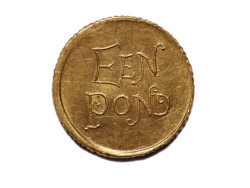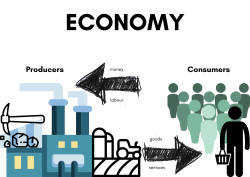NMAH and London School of Economics's collections
How did new African countries use money to show their independence?
<p>Starting in the late 1950s, African nations became independent from European colonial powers. They used their new currencies to demonstrate their sovereignty by replacing European heads of state with national leaders. The new national coins and banknotes also depicted indigenous currencies like cowrie shells in Ghana and kissi pennies in Liberia, celebrating African cultural heritage. </p>
 NMAH and London School of Economics
NMAH and London School of Economics
8
How did World War II affect West Africa?
<p>World War II was a global conflict affecting all regions of the world, including West Africa. Africans from British and French colonies fought all over the world in the militaries of their colonizers. When Germany invaded France in 1940, Africans in French colonies were divided between the Vichy government in West Africa and the Free French resistance in Central Africa. The currencies issued by the two separate governments illustrate this divide. </p>
 NMAH and London School of Economics
NMAH and London School of Economics
5
Money and Exchange in South Africa
<p dir="ltr">The history of money in South Africa over the last two centuries can be described as a tale of paper and gold. Flimsy banknotes first printed in the Cape of Good Hope in the 1820s start the story with the formation of a private banking system linked to the entrenchment of British colonial rule. Delicately engraved gold bars and coins bring us through the second half of the nineteenth century. This era was shaped by the establishment of an imperial mining system, accompanied by destructive wars that paved the way for the brutal apartheid system that dominated South African politics in the second half twentieth century. Colorful post-apartheid banknotes featuring South African President Nelson Mandela and symbols of African culture and identity bring us to the present day. </p>
<p dir="ltr"> </p>
<p dir="ltr">While the story of money in South Africa includes many other forms of money, particularly indigenous currencies such as beads and livestock that circulated at the same time as coins and notes, the objects in this learning lab provide a picture of how South Africa transformed from a politically divided agricultural economy to the world’s leading gold producer and Africa’s most developed economy. </p>
<p dir="ltr"> </p>
<p dir="ltr">Following colonization by the Dutch and British, the slow and often violent process of political consolidation was reflected in South Africa’s money, with the adoption first of coins based on British sterling and then, under the apartheid regime adopted in 1948, the rand. As apartheid South Africa distanced itself from Britain and became increasingly isolated, its money depicted figures associated with history of the Afrikaner ruling party, such as Jan van Riebeeck and Paul Kruger. With the fall of apartheid and the shift to democracy in 1994, these divisive figures were eventually replaced by Nelson Mandela.</p>
<p dir="ltr"> </p>
<p dir="ltr">Covering two centuries, these objects from the National Numismatic Collection tell the story of South Africa’s path from company and colonial rule to apartheid to the rainbow nation. </p>
<p dir="ltr">This learning lab is based on a recent article on the material history of money in South Africa:</p>
<p dir="ltr"><a href="https://www.tandfonline.com/doi/full/10.1080/20780389.2021.1926232">Feingold, Ellen, Johan Fourie, and Leigh Gardner. "A Tale of Paper and Gold: The Material History of Money in South Africa." <em>Economic History of Developing Regions </em>36, no. 2 (2021): 264-281.</a> </p>
<p dir="ltr">Below is a list of additional suggested readings on money and exchange in South Africa. To see all of the South African currency objects in the <a href="https://americanhistory.si.edu/national-numismatic-collection">National Numismatic Collection</a>, click <a href="https://americanhistory.si.edu/collections/search?edan_q=&edan_fq[]=set_name:%22South+African+Currency%22&custom_search_id=collections-search">here</a>. </p>
<p dir="ltr">This project was generously funded by the <a href="https://info.lse.ac.uk/staff/services/knowledge-exchange-and-impact">Knowledge Exchange and Impact Fund</a> at the London School of Economics. Please feel free to reach out to <a href="https://www.lse.ac.uk/Economic-History/People/Faculty-and-teachers/Dr-Leigh-Gardner">Dr. Leigh Gardner</a> or <a href="mailto:feingolde@si.edu">Dr. Ellen Feingold</a> with questions or feedback. <br><br><br></p>
<p dir="ltr">Suggested Reading:</p>
<p dir="ltr">Comaroff, Jean, and John L. Comaroff. 2005. “Beasts, Banknotes and the Colour of Money in Colonial South Africa.” <em>Archaeological Dialogues</em> 12 (2): 107–132.</p>
<p dir="ltr">Feinstein, Charles. 2005. <em>An Economic History of South Africa: Conquest, Discrimination and</em></p>
<p dir="ltr"><em>Development</em>. Cambridge: Cambridge University Press.</p>
<p dir="ltr">Havemann, Roy. 2014. “The Exchange Control System Under Apartheid.”<em> Economic History of Developing Regions</em> 29 (2): 268–286.</p>
<p dir="ltr">Lukasiewicz, Mariusz. 2017. “From Diamonds to Gold: The Making of Johannesburg Stock Exchange, 1880–1890.”<em> Journal of Southern African Studies</em> 43 (4): 715–732.</p>
<p dir="ltr">Ross, Robert. 2008. <em>A Concise History of South Africa</em>. Cambridge: Cambridge University Press.</p>
<p dir="ltr">Wood, Marilee. 2011. “A Glass Bead Sequence for Southern Africa from the 8th to the 16th Century AD.” <em>Journal of African Archaeology</em> 9 (1): 67–84.</p>
<p dir="ltr">Additional early histories of money in South Africa: </p>
<p dir="ltr">Arndt, E. H. D. 1928. <em>Banking and Currency Development in South Africa (1652–1927)</em>. Cape Town: Juta & Co.</p>
<p dir="ltr">Becklake, J. T. 1963. <em>From Real to Rands: The Story of Money, Medals and Mints in South Africa</em>. Johannesburg: Central News Agency.</p>
<p dir="ltr">Bergman, W. 1971. <em>A History of the Regular and Emergency Paper Money Issues of South Africa</em>. Cape Town: Derek Butcher & Co.</p>
<p><br></p>
 NMAH and London School of Economics
NMAH and London School of Economics
10
South African lesson 2: Minerals and Money
<p>This lesson explores how currencies are used in different economies, with a focus on South Africa and how the Mineral Revolution in South Africa affected its economies and currencies.</p>
<p>*This lesson was developed and created by a South African History graduate (Amy Rommelspacher, amyrom@sun.ac.za), as part of a collaboration between Stellenbosch University, the London School of Economics and the Smithsonian with a goal of creating lesson plans for South African students using objects from the National Numismatic Collection. There are four lessons in total.</p>
<p>Find the next lessons here:</p>
<p><a href="https://learninglab.si.edu/collections/south-african-lesson-3-the-great-depression-the-gold-standard-and-south-africa/HPZ2cJN1jRXri3mg">South African lesson 3: The Great Depression, the gold standard and South Africa</a></p>
<p><a href="https://learninglab.si.edu/collections/south-african-lesson-4-bretton-woods-national-currencies-and-south-africa-s-new-money/DvAXfJ1hzRn5YxpU">South African lesson 4: Bretton Woods, national currencies and South Africa's new money</a></p>
 NMAH and London School of Economics
NMAH and London School of Economics
13
South African lesson 3: The Great Depression, the gold standard and South Africa
<p>This lesson looks at the Great Depression and the gold standard in South Africa and how these impacted the way that money worked in the country, and many other countries in the world.</p>
<p>*This lesson was developed by a South African History graduate (Amy Rommelspacher, amyrom@sun.ac.za), as part of a collaboration between Stellenbosch University, the London School of Economics and the Smithsonian with a goal of creating lesson plans for South African students using objects from the National Numismatic Collection. There are four lessons in total.</p>
<p>Find the next lesson here:</p>
<p><a href="https://learninglab.si.edu/collections/south-african-lesson-4-bretton-woods-national-currencies-and-south-africa-s-new-money/DvAXfJ1hzRn5YxpU">South African lesson 4: Bretton Woods, national currencies and South Africa's new money</a><br></p>
 NMAH and London School of Economics
NMAH and London School of Economics
14
U.S. Dollars in Liberia
<p><strong><em><a href="https://americanhistory.si.edu/national-numismatic-collection/galleries-and-exhibitions">The Value of Money</a></em> exhibition's new acquisition case is currently featuring a display on the use of <a href="https://americanhistory.si.edu/blog/dollars-liberia">U.S. Dollars in Liberia</a>. This Learning Lab makes this display available digitally. </strong></p>
<p><strong><u>U.S. Dollars in Liberia </u></strong></p>
<p>From 1820 to 1904, about 16,000 people formerly enslaved in the United States sailed to West Africa and established the country now known as Liberia. The American Colonization Society, which sought to create a colony in Africa for formerly enslaved people, issued currency like this 1833 token and established a government led by white officials. <br></p>
<p>In 1847 Liberian migrants declared independence from the American Colonization Society and issued their own coins as a symbol of nationhood. The coins were minted in England and circulated alongside indigenous currencies like the Kissi penny. In the late 19th and early 20th century, the Liberian government struggled with debt, making it difficult for the Liberian dollar to maintain its value. As a result, merchants and then the government began to use the colonial currency of British West Africa instead. </p>
<p>In 1943, with financial help from the U.S. government, the U.S. dollar replaced British West African shillings as the primary currency in circulation. The Liberian dollar continued to be in use as small change. Today Liberia is one of few nations with a dual currency system, as both American and Liberian dollars circulate alongside each other. In 2019 the National Numismatic Collection acquired contemporary Liberian banknotes to help tell this story. </p>
<p><strong><u>Suggested Reading:</u></strong></p>
<p>Gardner, Leigh A. "The rise and fall of sterling in Liberia, 1847-1943." <em>Economic History Review</em> 67, no. 4 (2014): pp. 1089-1112. </p>
<p>Rosenberg, Emily S. <em>Financial Missionaries to the World: The Politics and Culture of Dollar Diplomacy 1900-1830</em>. Chapel Hill: Duke University Press, 2007. </p>
<p><br></p>
<p>To see all of the West African currency objects in the National Numismatic Collection, click <a href="https://americanhistory.si.edu/collections/search?edan_q=west%20african%20currency&edan_local=1&edan_fq%5B%5D=topic:%22West+African+Currency%22">here</a>. <br><br><br><br></p>
 NMAH and London School of Economics
NMAH and London School of Economics
7




